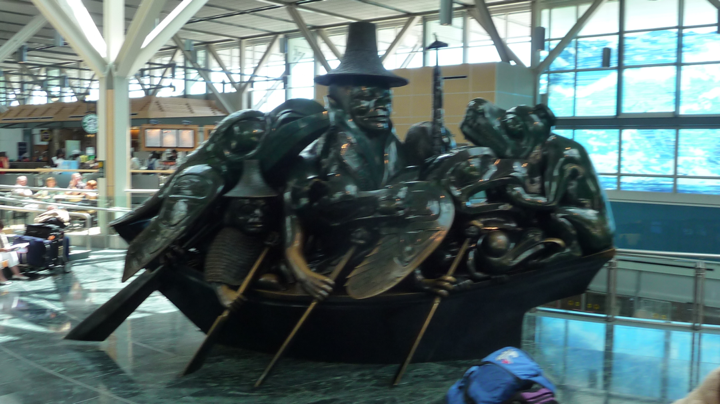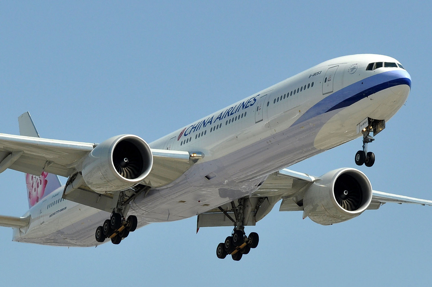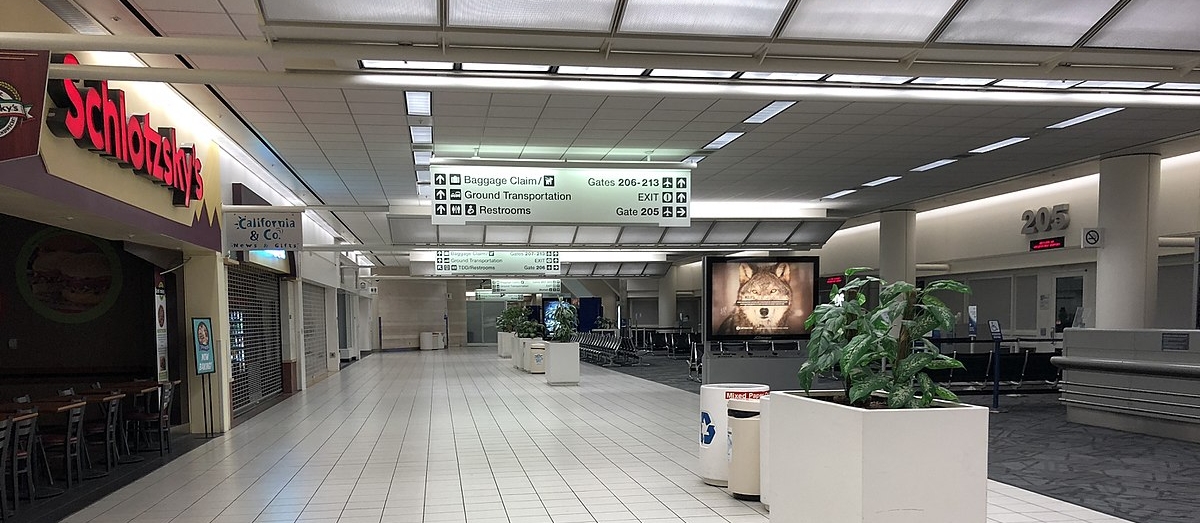Ontario - ONT
/Photo by ERIC SALARD via Flickr, CC 2.0 license
The Inland Empire lands its first Asian flight
In the 1970s and early 1980s, the airport at Ontario, California was a busy alternative to crowded Los Angeles International, and carriers like United, American, Western, and Continental ran mainline services to their national hubs, while regional carriers like PSA, AirCal, Hughes Airwest, and Alaska covered the West Coast.
ONT was managed by the same authority as LAX, and concentrated their investment on the latter airport, first to handle the surge of traffic for the 1984 Olympics and then to manage the consolidation of the airline industry: American, United, and Delta all wanted to establish hubs there. Ontario was assigned ever-higher cost burdens to help finance development at LAX, which drove traffic away. It took until the late 1990s for ONT to get a replacement for its 1960s-era terminal, and arguments about costs and local control continued into the 2010s, when the airport authority was devolved to Ontario and San Bernardino.
Image by jennifer via Flickr, CC 2.0 license
Since its independence from LAX at the end of 2016, Ontario Airport has been working to lower its costs and attract new flights. The “Inland Empire” was hit hard by the 2008 Great Recession, but its recovery has been strong, and its location outside the road and rail snarls of Los Angeles proper – yet on the mainline interstates and railroads - has made it an important logistics hub: both UPS and FedEx have made ONT into key facilities for all Southern California.
Asian-American communities have steadily grown on the eastern side of Los Angeles, in Orange County, and on the northern side of San Diego. These communities would like (and are willing to pay for) convenient flight options to East and Southeast Asia, but Santa Ana’s airport is locked in to a short runway and limited hours which prevents long-range flights, and San Diego’s configuration is adequate only for Japan Airlines’ 787 nonstop to Tokyo – nothing bigger or with longer range. Up until this point, that meant travelers would have to endure long highway journeys to LAX. ONT, however, is convenient to the I-15 and Cal-91/Cal-60 corridors, has a very long runway, and is not subject to noise or frequency restrictions. While it may be similar road mileage from these communities versus LAX, the driving time can be literally hours better.
ONT management has been touting these advantages to Asian carriers, and in September 2017 they reached agreement with Taiwan’s China Airlines to begin nonstop service to Taipei:
Beginning March 25, 2018, with four flights per week:
- Flight CI 24 – Departs Taipei Taoyuan (TPE) 4:10 pm, arrives ONT 1:20 pm same day
- Flight CI 25 – Departs ONT 3:45 pm, arrives TPE 8:55 pm next day
The arrival time at Taipei will allow same-evening connections to Bangkok and Hong Kong, while the afternoon departure from TPE connects in from those two cities as well as many more from Southeast Asia and mainland China.
It is expected frequency will eventually become daily on this service. China Airlines will use its Boeing 777-300 on the route.
Photo by joolsgriff via Flickr, CC 2.0 license
China Airlines’ SkyTeam partner, Delta, only flies to ONT from its hub in Salt Lake City, and the arrival/departure times for those flights would be terribly inconvenient to make connections (5-6 hour waits). So this flight is truly dedicated to serving local passenger and cargo customers for eastern L.A. and San Diego.
Customs Arrival
Ontario uses a dedicated, separate building for international arrivals needing Customs clearance. After landing, passengers will exit the airplane via stairs and walk outside on the apron to an enclosed walkway. Passport control is immediately inside, and then baggage claim. Passengers not needing to declare items at Customs may exit directly.
Average times to clear Customs at ONT currently run 15-30 minutes; on the lower end of the range for US citizens and the higher end for non-citizens. This is based off arrivals data for Aeromexico and Volaris flights coming in from Mexican cities – with the important note that those flights are on smaller 737 and A320 aircraft. China Airlines’ 777-300 will carry about twice as many passengers, so longer processing times should be expected. No other international arrivals will be taking place when the Taipei flight comes in, so this will help; we will need to see how US CBP staffs to serve this time of day to get a real sense of processing time.
There are no baggage recheck counters at the international arrivals building, or shops, just restrooms and doors outside to catch a shuttle bus to the other terminals, parking lots, and ground transportation center. The shuttle runs every 15-20 minutes, 24 hours per day.
Image via Google Maps. Click to expand view.
Navigating the airport
International departures from Ontario leave from Terminal 2, and SkyTeam partners Delta and Aeromexico are also housed there. Check-in is on ground level, with the security checkpoint upstairs and gates just beyond.
ONT’s terminals are laid out in a straight line, with gates on the air-side and services on the land-side. Terminal 2 at present has only 12 gates so walking distance is minimal. (Click here for a terminal map.)
Image by Vmzp85 via Wikimedia Commons, CC 4.0 license
Family-friendly amenities and hidden gems
The terminal was built with the intention of quickly moving passengers between the airplanes and parking lot – not for spending extended time there, or for making connections – so it’s a stripped-down building with just the basics. There aren’t any play facilities or kid-oriented artworks. There is a nursing area tucked in between the women’s restroom entrance and the vending machine complex across from Gate 207.
If your kids enjoy watching aircraft on the ramp and runways, the big windows do afford a good view of the action. The space just outside security gives the best panorama in Terminal 2.
Image by Zhao Shouren via Flickr, CC 2.0 license
Image by Vmzp85 via Wikimedia Commons, CC 4.0 license
Restrooms
Terminal 2 was opened in 1998 so restrooms are up to ADA standards. There is one family-size restroom directly across from Gate 206, between the ATM and the men’s restroom entrance.
Image by Vmzp85 via Wikimedia Commons, CC 4.0 license
Food and Shopping
At present there are only two prepared food outlets in Terminal 2 (one Mexican and one sandwich shop), plus an array of packaged-food vending machines. Likewise there is only one newsstand and one general-merchandise shop: nothing in particular oriented toward children, but more along the lines of last-minute needs, reading material, and gifts.
There is space in the concourse for additional food and retail, but traffic through the building needs to dramatically increase to attract and keep more tenants.
Connectivity
Wi-Fi is free and strong throughout the airport.
ONT is situated between Metrolink’s Riverside And San Bernardino lines, but neither has a station at the airport. The local bus system, Omnitrans, offers service every 15 minutes from Terminals 2 and 4 along their route #61, which links the Pomona station on the Riverside line, and the Fontana station on the San Bernardino line. Bus route #80 with hourly service, reaches the Ontario Convention Center, Alta Loma, and Rancho Cucamonga.
Lodging
There are several family-friendly hotel chains nearby with free shuttle service to ONT, if you were going to drive in the night before your flight:
- Holiday Inn Ontario Airport
- Azure Hotel & Suites Ontario Airport
- Best Western Plus Ontario Airport
- DoubleTree by Hilton Ontario Airport
- Residence Inn by Marriott Ontario Airport
- Sheraton Ontario Airport
- Embassy Suites Ontario Airport
See also…
http://www.latimes.com/local/lanow/la-me-ln-ontario-airport-20161101-story.html





















































